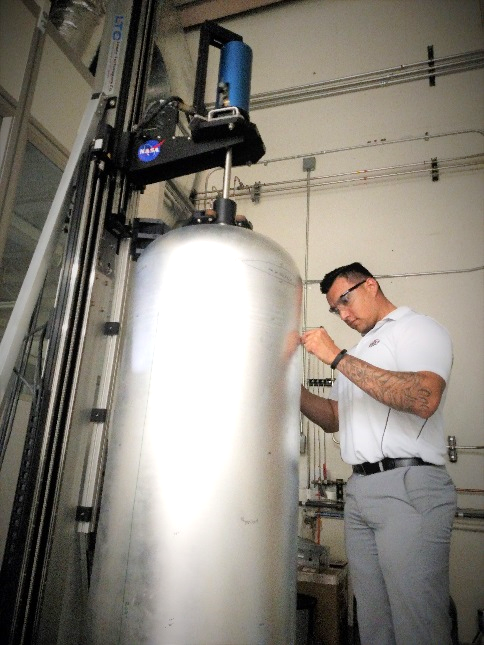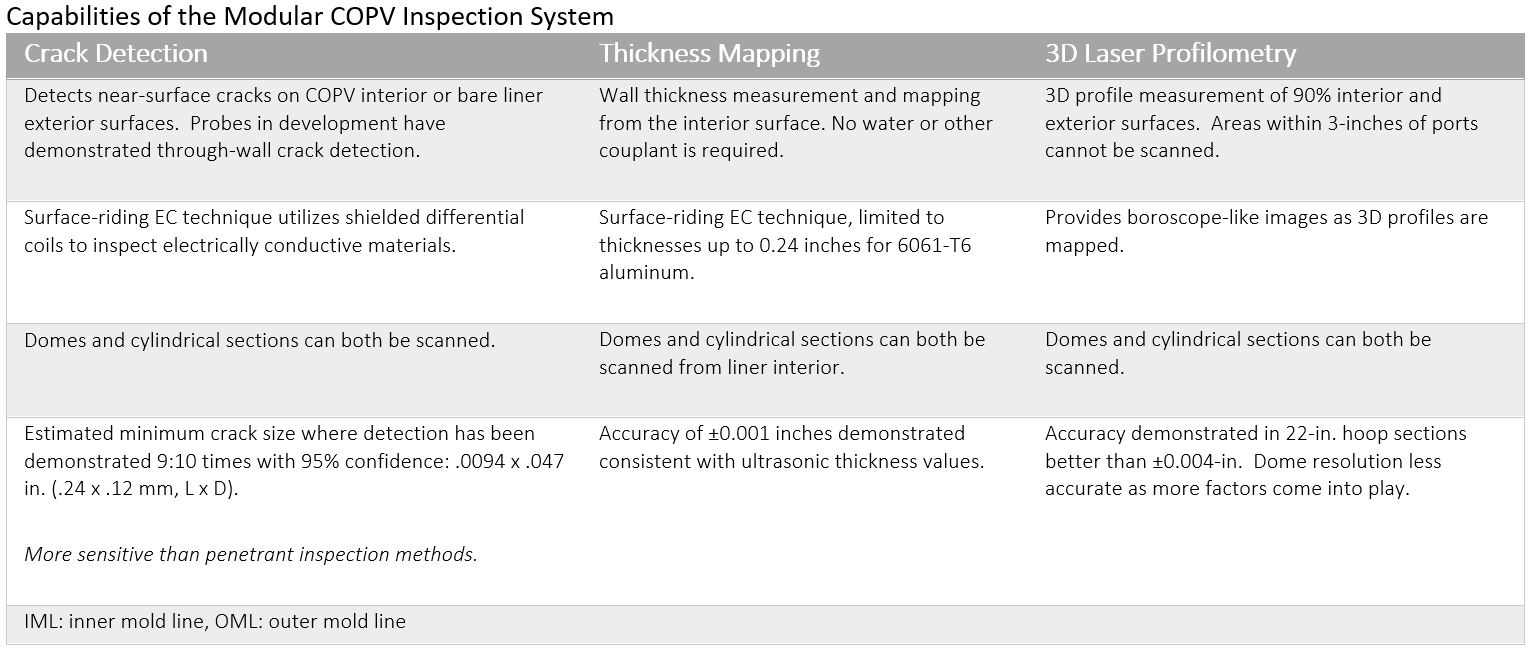Made With Mars in Mind — Development of a Multipurpose Inspection System for COPVs
NASA and industry are working together to meet the safety, schedule and efficiency demands for current and future space flights,
including those to and from the International Space Station (ISS).
Weight savings are key to space exploration and high-performance Composite Overwrapped Pressure Vessels (COPVs), which weigh
25 to 75 percent less than their metal counterparts, are on the “must-go” list for all flights including
the agency’s journey to Mars. As higher performing COPV designs continue to push structural limits, Nondestructive
Evaluation (NDE) methods must also evolve to detect smaller flaws and pave the way for lighter components for deep space
exploration.
Interest in COPV inspection system development increased after a series of failed launches involving commercial spacecraft.
In 2014, two commercial spacecraft launches were scrubbed due to COPV failures. These were followed by commercial spacecraft
failures in 2015 and 2016 that may have resulted from COPV deficiencies.

Jacobs Technology Inc. co-op student Raymond Stewart verifies measurements of a COPV liner during a laser profilometry
inspection at White Sands.
Existing NDE capabilities were unlikely to identify all features of interest with sufficient confidence, so NASA, at the
request of manufacturer COPV inspection teams, began developing a modular inspection system intended to serve as a demonstration
unit for various NDE techniques (
Fig. 1). The successful system development resulted from collaborative work between the Office of Safety and Mission
Assurance and the NASA Engineering and Safety Center (NESC).
Ralph Lucero, with Jacobs Technology Inc. at White Sands Test Facility, has worked extensively with this system from the
beginning.
“With its Eddy Current flaw detection capability, really small cracks are identified in thin-walled, lightweight, high-pressure
COPVs right after they’re made and tested on the ground,” he said, addressing one of the inspection capabilities.
“Screening out ‘bad’ COPVs before they get integrated onto the vehicles helps mitigate the risk of
COPV catastrophic failure, which can lead to loss of the spacecraft, its payload and the overall mission.”
A similar pressure vessel inspection system was first demonstrated to a COPV manufacturer in 2011 (ATK in Clearfield, Utah)
during the development of Nitrogen and Oxygen Recharge System (NORS) COPVs destined to resupply the ISS. The NORS COPV
inspection system proved to be effective at inspecting geometric defects in quality for the circumferential welds used
for dome attachment and was highly effective at identifying impact damage, contamination, simulated disbonds and interior
surface blemishes.
In the current configuration of the system, known as the Multipurpose Pressure Vessel Scanner (MPVS), a wide variety of inspection
technologies have been adapted into a 14-foot-tall COPV inspection system, which holds pressure vessels weighing up to
500 pounds with outer diameters up to 22 inches and lengths up to 61 inches. The modularity of the MPVS allows several
NDE techniques to be performed by simply interchanging the dedicated probes required for each. NASA and COPV manufacturer
inspection teams continue to work together on this project, and the plan is for manufacturers to use similar systems
on‑site, greatly increasing the ability to find defects early in the life cycle of the part.
Capabilities of the modular COPV inspection system are described in the following table. They include near-surface Eddy Current
(EC) crack detection (see
Fig. 2) with an estimated Probability of Detection (POD) far exceeding special fluorescent dye penetrant methods.
Cracks can be inspected from the pressure vessel interior or exterior, including curved sections of the domes. Through-thickness
surface crack inspection capabilities are also being developed. COPV thickness measurement and mapping from the pressure
vessel interior are accommodated by the system’s surface-riding EC probe (see
Fig. 3 and
Fig. 4). Pressure vessel interior and exterior surfaces can be 3D mapped, providing borescope-like images, using
laser profilometry probes (see
Fig. 5).

This system has inspired the creation of similar inspection capabilities at spacecraft manufacturers. The MPVS is currently
being used to support a NASA-led anomaly investigation chaired by the NESC and had completed more than 50 COPV or liner
inspections for that investigation as of 2017, and scans are continuing into 2018.
Future Work
The system has advanced significantly in the past couple of years and additional assessments characterizing the capabilities
of the MPVS are currently underway. These include through-wall detection of exterior liner cracks from the inside and
detection of cracks in liner domes. The through-wall capability, applied from the inside, is deemed especially important
to allow inspection of any crack growth during proof pressure and autofrettage, which has been a serious concern for
years. The NESC is also supporting the fabrication of a half-dozen more COPV liners for NDE physical reference standards
that will be required for the evaluation of MPVS capabilities, which will be shared throughout the NASA and spacecraft
manufacturing communities.
A variety of system improvements geared toward improving system accuracy are also being performed. New probes being developed
in Fiscal Year 2018 include an improved liner sidewall thickness measurement probe and an array-type flaw detection probe
that will improve inspection turnaround, a feature suggested by manufacturers with high throughput requirements. Future
work requested by the NASA COPV community include enlargement of the MPVS in preparation for inspecting COPVs larger
than 310 liters and ultrasonic sensing capabilities.
For guidance on developing a COPV inspection system or more information on the MPVS, contact
Charles Nichols, White Sands, or
William Prosser, NESC.